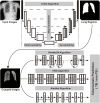Artificial Intelligence Assisting the Early Detection of Active Pulmonary Tuberculosis From Chest X-Rays: A Population-Based Study
- PMID: 35463963
- PMCID: PMC9023793
- DOI: 10.3389/fmolb.2022.874475
Artificial Intelligence Assisting the Early Detection of Active Pulmonary Tuberculosis From Chest X-Rays: A Population-Based Study
Abstract
As a major infectious disease, tuberculosis (TB) still poses a threat to people's health in China. As a triage test for TB, reading chest radiography with traditional approach ends up with high inter-radiologist and intra-radiologist variability, moderate specificity and a waste of time and medical resources. Thus, this study established a deep convolutional neural network (DCNN) based artificial intelligence (AI) algorithm, aiming at diagnosing TB on posteroanterior chest X-ray photographs in an effective and accurate way. Altogether, 5,000 patients with TB and 4,628 patients without TB were included in the study, totaling to 9,628 chest X-ray photographs analyzed. Splitting the radiographs into a training set (80.4%) and a testing set (19.6%), three different DCNN algorithms, including ResNet, VGG, and AlexNet, were trained to classify the chest radiographs as images of pulmonary TB or without TB. Both the diagnostic accuracy and the area under the receiver operating characteristic curve were used to evaluate the performance of the three AI diagnosis models. Reaching an accuracy of 96.73% and marking the precise TB regions on the radiographs, ResNet algorithm-based AI outperformed the rest models and showed excellent diagnostic ability in different clinical subgroups in the stratification analysis. In summary, the ResNet algorithm-based AI diagnosis system provided accurate TB diagnosis, which could have broad prospects in clinical application for TB diagnosis, especially in poor regions with high TB incidence.
Keywords: artificial intelligence; chest radiograph; deep convolutional neural network; machine learning; tuberculosis.
Copyright © 2022 Nijiati, Ma, Hu, Tuersun, Abulizi, Kelimu, Zhang, Li and Zou.
Conflict of interest statement
The authors declare that the research was conducted in the absence of any commercial or financial relationships that could be construed as a potential conflict of interest.
Figures





Similar articles
-
Machine and Deep Learning for Tuberculosis Detection on Chest X-Rays: Systematic Literature Review.J Med Internet Res. 2023 Jul 3;25:e43154. doi: 10.2196/43154. J Med Internet Res. 2023. PMID: 37399055 Free PMC article.
-
Artificial Intelligence Algorithm Detecting Lung Infection in Supine Chest Radiographs of Critically Ill Patients With a Diagnostic Accuracy Similar to Board-Certified Radiologists.Crit Care Med. 2020 Jul;48(7):e574-e583. doi: 10.1097/CCM.0000000000004397. Crit Care Med. 2020. PMID: 32433121
-
Evaluation of an artificial intelligence (AI) system to detect tuberculosis on chest X-ray at a pilot active screening project in Guangdong, China in 2019.J Xray Sci Technol. 2022;30(2):221-230. doi: 10.3233/XST-211019. J Xray Sci Technol. 2022. PMID: 34924433 Free PMC article.
-
Comparison of Chest Radiograph Interpretations by Artificial Intelligence Algorithm vs Radiology Residents.JAMA Netw Open. 2020 Oct 1;3(10):e2022779. doi: 10.1001/jamanetworkopen.2020.22779. JAMA Netw Open. 2020. PMID: 33034642 Free PMC article.
-
Benchmarking the diagnostic test accuracy of certified AI products for screening pulmonary tuberculosis in digital chest radiographs: Preliminary evidence from a rapid review and meta-analysis.Int J Med Inform. 2023 Sep;177:105159. doi: 10.1016/j.ijmedinf.2023.105159. Epub 2023 Aug 2. Int J Med Inform. 2023. PMID: 37549498 Review.
Cited by
-
The Application of Artificial Intelligence in the Diagnosis and Drug Resistance Prediction of Pulmonary Tuberculosis.Front Med (Lausanne). 2022 Jul 28;9:935080. doi: 10.3389/fmed.2022.935080. eCollection 2022. Front Med (Lausanne). 2022. PMID: 35966878 Free PMC article. Review.
-
A prospective multicenter clinical research study validating the effectiveness and safety of a chest X-ray-based pulmonary tuberculosis screening software JF CXR-1 built on a convolutional neural network algorithm.Front Med (Lausanne). 2023 Aug 15;10:1195451. doi: 10.3389/fmed.2023.1195451. eCollection 2023. Front Med (Lausanne). 2023. PMID: 37649977 Free PMC article.
-
Empowering public health: Leveraging AI for early detection, treatment, and disease prevention in communities - A scoping review.J Postgrad Med. 2025 Apr 1;71(2):74-81. doi: 10.4103/jpgm.jpgm_634_24. Epub 2025 Jun 9. J Postgrad Med. 2025. PMID: 40488301 Free PMC article.
-
Tuberculosis Diagnosis: Current, Ongoing, and Future Approaches.Diseases. 2024 Sep 3;12(9):202. doi: 10.3390/diseases12090202. Diseases. 2024. PMID: 39329871 Free PMC article. Review.
-
Application of a Deep Learning Approach to Analyze Large-Scale MRI Data of the Spine.Healthcare (Basel). 2022 Oct 26;10(11):2132. doi: 10.3390/healthcare10112132. Healthcare (Basel). 2022. PMID: 36360473 Free PMC article.
References
-
- He K., Zhang X., Ren S., Sun J. (2016). “Deep Residual Learning for Image Recognition,” in Proceedings of the 2016 IEEE Conference on Computer Vision and Pattern Recognition (CVPR), Las Vegas, NV, USA, December 2016. 10.1109/cvpr.2016.90 - DOI
-
- Krizhevsky A., Sutskever I., Hinton G. (2012). ImageNet Classification with Deep Convolutional Neural Networks. Commun. ACM 60, 84–90. NIPS. 10.1145/3065386 - DOI
-
- Organization W. H. (2016). Chest Radiography in Tuberculosis Detection: Summary of Current WHO Recommendations and Guidance on Programmatic Approaches. Geneva: World Health Organization.
-
- Organization W. H. (2021). WHO Consolidated Guidelines on Tuberculosis: Module 2: Screening: Systematic Screening for Tuberculosis Disease. Geneva: World Health Organization. - PubMed
LinkOut - more resources
Full Text Sources
Research Materials

